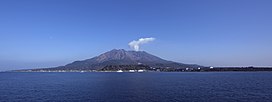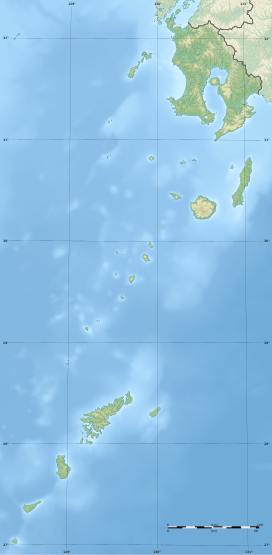
Back Sakurajima Afrikaans ساكوراجيما Arabic Сакурадзіма Byelorussian Сакураджима Bulgarian সাকুরাজিমা Bengali/Bangla Sakurajima Catalan Sakura Jima (pulo sa Hapon, Kagoshima-ken) CEB Sakura-džima Czech Sakurajima Danish Sakurajima German
| Sakurajima | |
|---|---|
 View of Sakurajima from mainland Kagoshima, 2009 | |
| Highest point | |
| Elevation | 1,117 m (3,665 ft) |
| Coordinates | 31°34′50″N 130°39′29″E / 31.58056°N 130.65806°E |
| Geography | |
Kagoshima Prefecture, Japan | |
| Geology | |
| Mountain type | Somma-stratovolcano |
| Last eruption | 1955-present[1] |
Sakurajima (Japanese: 桜島, lit. 'Cherry Blossom Island') is an active stratovolcano, formerly an island and now a peninsula, in Kagoshima Prefecture in Kyushu, Japan.[2] The lava flows of the 1914 eruption connected it with the Ōsumi Peninsula.[3] It is the most active volcano in Japan.[4]
As of April 2021[update], the volcanic activity still continues,[5] dropping volcanic ash on the surroundings. Earlier eruptions built the white sand highlands in the region. On September 13, 2016, a team of experts from Bristol University and the Sakurajima Volcano Research Centre in Japan suggested that the volcano could have a major eruption within 30 years; since then two eruptions have occurred.[6]
Sakurajima is a stratovolcano. Its summit has three peaks, Kita-dake (northern peak), Naka-dake (central peak) and Minami-dake (southern peak) which is active now.
Kita-dake is Sakurajima's highest peak, rising to 1,117 m (3,665 ft) above sea level. The mountain is in a part of Kagoshima Bay known as Kinkō-wan. The former island is part of the city of Kagoshima which is only 4km across the bay.[7] The surface of this volcanic peninsula is about 77 km2 (30 sq mi).
Sakurajima has a population of a few thousand residents, formerly incorporated as Sakurajima town, with a number of schools, shrines, and shops on the island. It is serviced by the Sakurajima Ferry which runs 24/7. It is a tourist destination known for its onsen, local pottery made from volcanic ash, and produce such as the Sakurajima daikon radish and Sakurajima komikan orange which grow in the immensely fertile volcanic soil.
Sakurajima has many natural areas and the ecosystems in different areas where recent eruptions have taken place have been researched as an example of ecological succession.
- ^ "Sakurajima volcano". 31 Jan 2019.
- ^ Nussbaum, Louis-Frédéric. (2005). "Sakurajima" in Japan Encyclopedia, p. 814; see photo, caption -- Kagoshima after Sakurashima eruption, Illustrated London News. January 1914.
- ^ Davison C (1916-09-21). "The Sakura-Jima Eruption of January, 1914". Nature. 98 (2447): 57–58. Bibcode:1916Natur..98...57D. doi:10.1038/098057b0. S2CID 3964260.
- ^ "Sakurajima, Japan's Most Active Volcano". nippon.com. Nippon Communications Foundation. May 16, 2018. Retrieved August 2, 2018.
- ^ "Sakurajima Volcano Volcanic Ash Advisory: VA AT 20210405/0420Z FL050 EXTD NE OBS VA DTG: 05/0420Z to 5000 ft (1500 m)". volcanodiscovery.com. Retrieved 6 April 2021.
- ^ McCurry, Justin (13 September 2016). "New data points to major eruption of Japanese volcano". the Guardian. Retrieved 17 April 2018.
- ^ Nussbaum, "Kagoshima prefecture" at p. 447.

